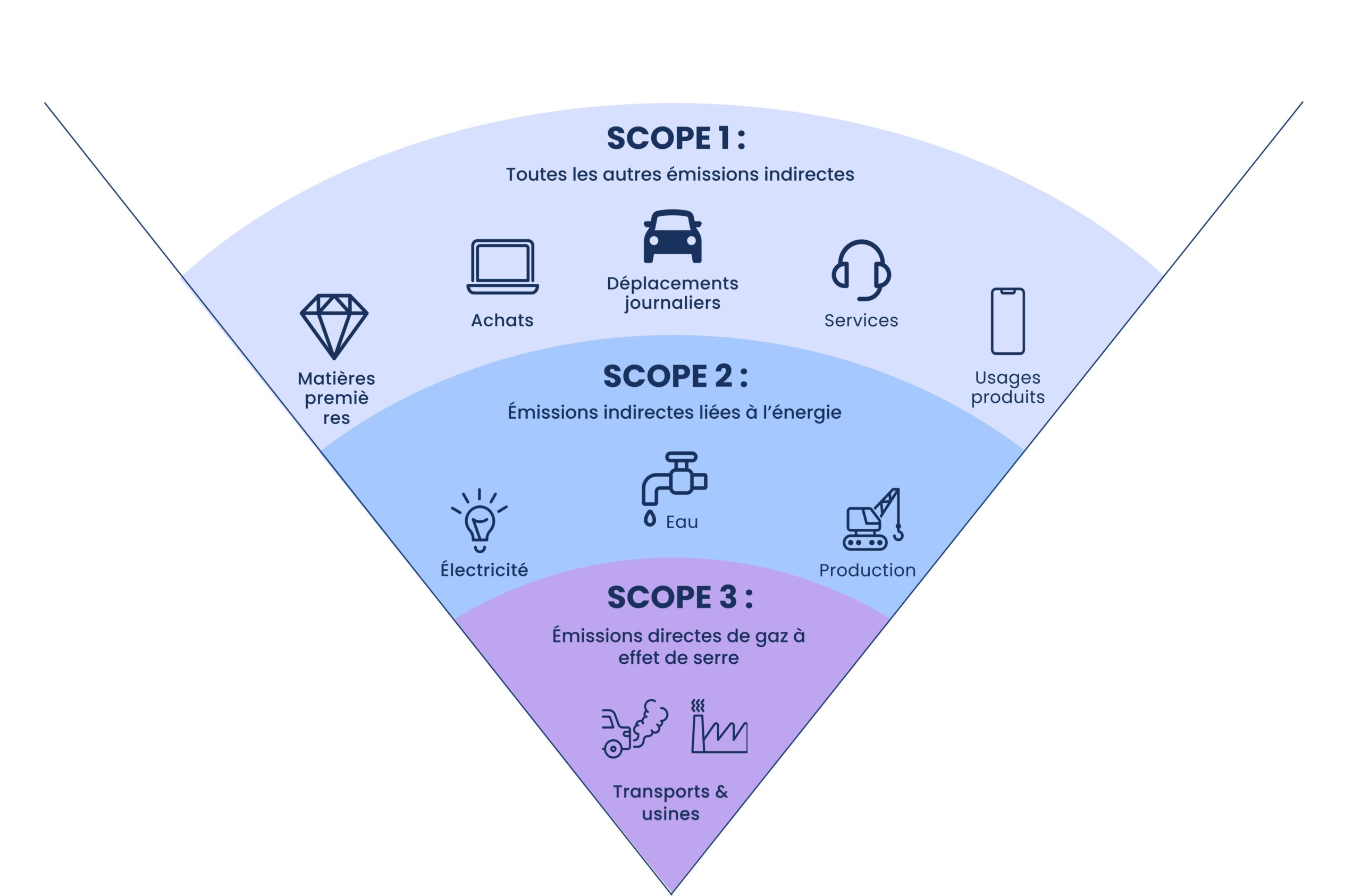
Initiate your company’s decarbonization by measuring its carbon footprint, setting the stage for continuous improvement and sustainability.
Conducting a carbon footprint assessment has become a legal requirement for many organizations. The goal is to encourage companies to assess, monitor, and reduce their greenhouse gas (GHG) emissions as part of the fight against climate change and its harmful effects.
What is the carbon footprint?
Introduction and definition
The carbon footprint measures the CO₂-equivalent emissions generated by a company’s activities. This tool not only helps companies comply with legislative and investor requirements, but also provides insight into the environmental impact of their emissions and highlights areas for improvement.
The purpose of this assessment is to increase awareness among companies about the primary sources of GHG emissions related to their operations, as well as the vulnerabilities linked to energy dependencies and climate change.
For companies, creating a GHG emissions profile enables forward-looking planning across short, medium, and long terms. It encourages them to establish and implement a transition plan to effectively reduce emissions, while proactively managing associated risks.
In this context, the carbon footprint is viewed as an essential first step in any decarbonization strategy and a foundation for guiding transition plans and low-carbon initiatives, such as defining an SBTi climate trajectory aligned with the Paris Agreement. Additionally, it enables companies to respond to and prepare for upcoming regulatory requirements regarding GHG emissions.
With an increasingly stringent legislative framework and expanding obligations for more types of entities, staying ahead of these developments is crucial to ensure compliance with current and future regulations.
Carbon footprint legislation
To help reduce GHG emissions and combat climate change and its harmful effects, the European Commission has introduced regulations that France is implementing at a national level, encouraging companies to assess, monitor, and reduce their environmental impact:
- The 2010 National Commitment to the Environment Act requires certain public and private entities to conduct GHG emissions assessments.
- The 2015 Energy Transition for Green Growth Act expanded the previous law by introducing periodic assessments, extending the interval to four years for companies and maintaining a three-year interval for the public sector.
- Since 2016, failure to complete a carbon footprint assessment has been punishable by a fine of up to €1,500.
- In 2019, the French Energy and Climate Act raised this penalty to a maximum of €10,000, or €20,000 for repeat offenses. Additionally, all carbon assessments completed since 2016 must be published on a digital platform managed by ADEME.
- Starting in 2024, the European CSRD directive mandates ESG data reporting from January 1, 2025, for companies with more than 500 employees and annual revenue exceeding €50 million.
Beyond regulatory requirements, carbon footprint assessments serve as a tool for continuous improvement. With access to various assessment methods, companies can progressively reduce process inefficiencies, enhance customer satisfaction, and mitigate risks.
How to calculate your carbon footprint?
Calculating a company’s carbon footprint is essential for identifying priority reduction actions, mitigating climate change, and fostering a transition to sustainable practices.
Methods for calculating your carbon footprint
To support companies in assessing their carbon footprint, several methods are tailored to different types of organizations and their unique needs:
- The Bilan Carbone® Method: created in 2004 by ADEME and supported by the “Association pour la Transition Bas Carbone” (ABC), this method is the benchmark for carbon accounting in France. It uses a specific methodology and tools to account for all GHG emissions—both direct and indirect—across an organization’s physical flows. It analyzes the main sources of emissions by categorizing them into six major groups. Additionally, this methodology enables companies to produce a BEGES report, which is mandatory in France for companies with over 500 employees and for local authorities, and is aligned with ADEME’s Bilan Carbone® standards.
- ISO 14064: an international standard for carbon footprint assessment, ISO 14064 provides a three-part methodology: data collection, data processing to quantify emissions from a company’s various activities, and verification of emissions declarations. It is commonly used for environmental certifications.
- GHG Protocol: by dividing GHG emissions into 3 scopes, this widely accepted international standard establishes a standardized framework for measuring, reporting, and managing emissions. It is used globally for consistent and transparent emissions accounting.
Focus on Scopes 1, 2, and 3
In the GHG Protocol’s emissions accounting framework, emissions sources are divided into three categories, or scopes:
- Scope 1: Direct emissionsScope 1 includes emissions directly associated with an organization’s activities, over which it has direct control, making it possible to implement immediate reduction measures. This category covers emissions from the combustion of fossil fuels (oil, gas, coal) by fixed or mobile equipment owned or controlled by the organization, such as heating company facilities, fuel combustion in company vehicles, and energy used in production.
- Scope 2: Indirect energy-related emissionsScope 2 accounts for indirect emissions from energy consumption that occur outside of the organization’s facilities. This scope allows companies to assess the impact of their energy sourcing decisions, particularly in relation to the consumption of electricity, heating, steam, or cooling.
- Scope 3: Other indirect emissionsScope 3 includes all other emissions generated along the company’s value chain, from supplier activities and employee travel to material purchases and end-of-life equipment disposal. While Scopes 1 and 2 are mandatory for all companies, Scope 3 reporting is only required for companies with over 500 employees.
Notably, the current legislative framework and scopes do not specifically address the digital aspect of the carbon footprint, which organizations often evaluate through varied approaches. However, given the significant environmental impact of digital technologies, it is increasingly important to incorporate this aspect into carbon assessments.
How to integrate IT in your carbon footprint?
In response to the exponential increase in GHG emissions, carbon footprint assessments help identify major emission sources and encourage companies to implement action plans to reduce their environmental impact.
The digital sector, often underestimated, represents a significant portion of an organization’s GHG emissions, particularly in the service sector. This makes it increasingly essential to precisely integrate digital activities into carbon footprints, initiating a Responsible Digital approach.
Tools like the Fruggr solution simplify the important, yet often complex, steps involved in calculating an IT carbon footprint. This SaaS software offers:
- An automated, multi-criteria assessment for a comprehensive view of your IT footprint.
- Reliable KPIs for ESG and CSR reporting, contributing directly to your company’s overall carbon footprint.
- Identification of primary emission sources and potential improvement levers to support decarbonization efforts.
- Assistance with eco-designing and optimizing digital services through life cycle assessments and accessibility analyses of your digital services.
Digital impact assessment tools raise awareness and promote best practices. Adopting such a tool is a foundational step toward a more sustainable, ethical, and efficient use of digital technology. The Fruggr solution, in particular, enables companies to carry out a digital carbon footprint assessment, providing a comprehensive view of their impact, retrieving necessary KPIs for carbon footprint reporting, and guiding a targeted decarbonization strategy.
Completing a carbon footprint assessment goes beyond regulatory compliance. By combining ecological and digital transitions, companies can not only reduce their environmental impact but also enhance overall performance. Through strategic and sustainable transformation, companies strengthen their ESG performance. A carbon footprint assessment provides a clear picture of emissions and highlights actionable areas for reducing impact and establishing a decarbonization pathway.
